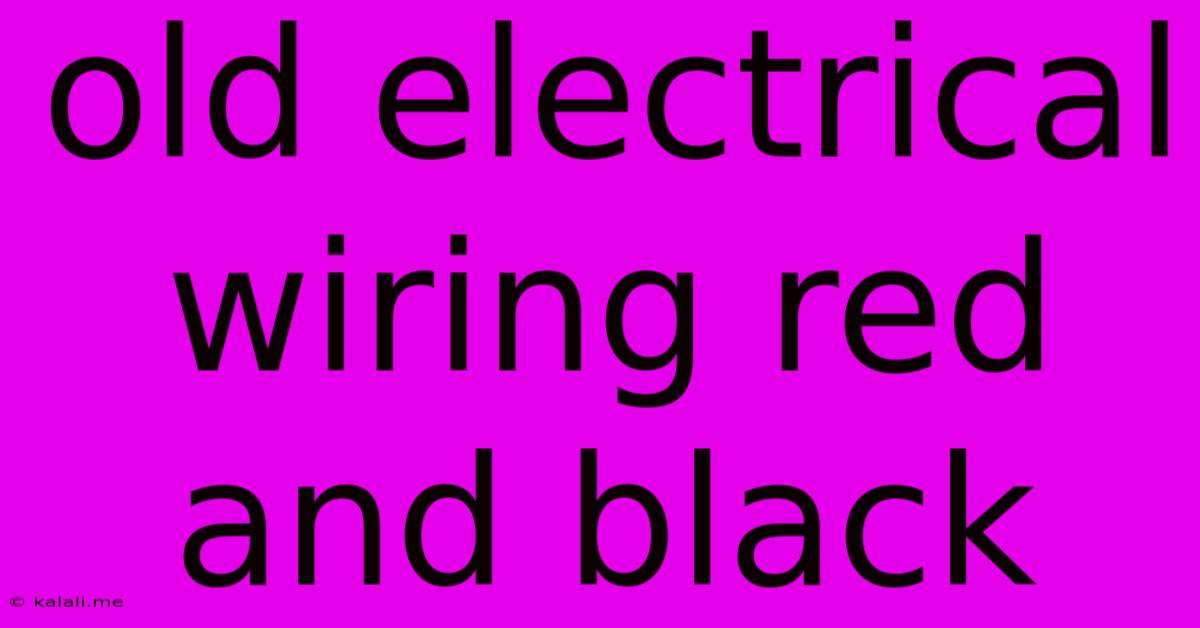Old Electrical Wiring Red And Black
Kalali
May 21, 2025 · 3 min read

Table of Contents
Decoding the Mystery: Red and Black Electrical Wiring in Older Homes
Understanding old electrical wiring, especially the common red and black wires, is crucial for homeowners, DIY enthusiasts, and electricians alike. This guide will delve into the history, purpose, and potential hazards associated with red and black wires found in older homes, offering insights into safe practices and necessary upgrades. This information is for general knowledge and should not replace professional advice from a qualified electrician.
The Evolution of Electrical Wiring Colors
Early electrical systems didn't follow the standardized color-coding we see today. Before the widespread adoption of the National Electrical Code (NEC), wire colors were inconsistent, leading to potential confusion and safety risks. Red and black wires, while now often associated with specific functions, held varied meanings in older homes. Identifying their purpose requires careful investigation and often, professional assistance.
Common Uses of Red and Black Wires in Older Homes
-
Hot Wires: In many older homes, both red and black wires served as "hot" wires, carrying the electrical current. This is a significant departure from modern conventions, where black typically denotes a hot wire and red is often used for switched hot wires or specific circuits. This dual-hot configuration necessitates extra caution during any electrical work.
-
Branch Circuits: Older homes often used red and black wires in branch circuits, the smaller circuits that power outlets and lights throughout the house. The lack of consistent color-coding in these circuits makes tracing the current path more challenging, increasing the risk of accidental shocks or electrical fires.
-
Appliance Wiring: Red and black wires could also be found in the internal wiring of older appliances. Identifying the function of each wire in these appliances is critical for safe repair or replacement. Always disconnect power before working with any appliance wiring.
Safety Concerns with Older Wiring
Working with old electrical wiring, especially with inconsistent color-coding, presents several safety concerns:
-
Shock Hazard: The potential for accidental contact with a hot wire is significantly higher when colors aren't standardized. This can lead to serious electric shock, potentially fatal.
-
Fire Hazard: Old wiring, particularly if improperly installed or damaged, can overheat and cause fires. Deterioration over time can lead to loose connections or frayed wires, increasing the fire risk.
-
Circuit Overload: Older systems may have inadequate amperage for modern appliances, leading to circuit overloads and potential fires.
-
Aluminum Wiring: Some older homes use aluminum wiring, which is more prone to overheating and connection failure compared to copper wiring.
Modern Wiring Standards and Upgrades
Modern electrical systems utilize a standardized color code for safety and consistency. Black usually represents the hot wire, white is neutral, and green or bare copper is the ground wire. Red is frequently used for switched hot wires or specific circuit applications, always adhering to the NEC guidelines.
If you're unsure about your home's wiring, it's crucial to consult with a licensed electrician. They can accurately identify the function of each wire, assess the condition of the wiring system, and recommend necessary upgrades or replacements. Upgrading to modern wiring is an important safety measure that can protect your home and family from electrical hazards. Don't hesitate to invest in this essential safety upgrade.
Identifying and Addressing Potential Problems
While inspecting your older home’s electrical system, look for signs of damage, including:
- Discoloration or scorching on wires or outlets: This may indicate overheating, a serious safety concern.
- Loose connections: These can cause overheating and potential fire hazards.
- Exposed wiring: This is a major safety risk and needs immediate attention.
- Outdated breaker box: An old breaker box may not provide adequate protection.
Remember, safety should be your top priority. If you're uncertain about any aspect of your home's electrical system, seek professional help immediately. A qualified electrician can perform a thorough inspection, identify potential hazards, and implement appropriate solutions. Don't risk your safety – a proactive approach to electrical safety is always worthwhile.
Latest Posts
Latest Posts
-
What Does Exclamation Mark Mean In Math
May 21, 2025
-
Can You Jumpstart A Diesel Car
May 21, 2025
-
I Hope You Are Well And
May 21, 2025
-
What Is Larger Than The Universe
May 21, 2025
-
Can I Take A Bottle Of Water On A Plane
May 21, 2025
Related Post
Thank you for visiting our website which covers about Old Electrical Wiring Red And Black . We hope the information provided has been useful to you. Feel free to contact us if you have any questions or need further assistance. See you next time and don't miss to bookmark.